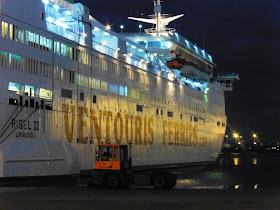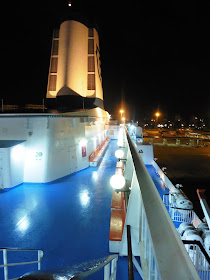15 August 2018
Ferrying in July 2018 Part 6, Rigel II
My friends wanted to visit some of the numerous travel agents in the town's main street and they did this whilst I strolled along nearby. They obtained several new-to-them ferry company brochures and were very happy. We finally arrived at the town square and could take an overhead walkway leading over a dual-carriageway road and right into the port ferry terminal. That felt much safer and the views in the gathering darkness were good too.
We had to queue to show our tickets and passports for only a couple of minutes and then we could walk out of the terminal and across to the RIGEL II.
Rigel II
Closer
The sisters
Side of GNV Azzurra
The two sister ships loomed ahead in the darkness, with lots of lights blazing from the public decks. We walked up one of the two ramps leading to the car decks on RIGEL II, and were directed up to Reception to collect cabin keys.
At last we are on board this 23,842 gross tons ship, built in 1980 as VISBY, and now named RIGEL II. This seems to be the sixth name in her life. One of my friends very kindly prepared a note about her history and here it is:
"In terms of Sealink she is one of a kind, but as built she was one of a pair, built for Rederi AB Gotland as the Visby and delivered in 1980; her sister was to have been the Gotland but never entered service as such.
The Gotlanders didn’t really want new ships by all accounts (their existing pair, the current SARDINIA REGINA and CORSICA VICTORIA, were less than a decade old) but the government leant on them to order the pair from a Swedish yard.
The VISBY was famously overweight when delivered so after some frantic weight-saving was only in intermittent use until the harbour in Visby could be dredged to accommodate her. In 1988 Rederi AB Gotland managed to lose the concession to operate the routes to Gotland so the ship was chartered to their replacements, Nordström & Thulin. N&T later half-owned Estline and were involved when the ESTONIA was lost, after which they renounced passenger shipping. The VISBY had moved on by that stage, becoming in 1990 a large and impressive presence on the St George’s Channel between Fishguard and Rosslare as Sealink’s FELICITY, later STENA FELICITY.
Rederi AB Gotland got their operation back in 1998 and reclaimed their ship from charter to operate to Gotland once more under her original name; by all accounts they were not enamoured with what eight years of Irish Sea passengers had thrown at her, so she was pretty comprehensively refitted into the style you still see on board today.
Replaced by new tonnage in 2003 she passed to Polferries for operation between Nynashamn and Gdansk (as SCANDINAVIA) and thence to Ventouris Ferries in 2015 becoming the RIGEL II for whom she has operated the Bari-Durres route ever since.
Her unwanted sister enjoyed a varied early career, initially as the WASA STAR. In 1983 she was improbably chartered to Karageorgis who sailed her to the Adriatic and put her into service between Ancona and Patras. This did not end well with rumours of unpaid charter fees and after a couple of months a Swedish crew was despatched to commandeer the ship and sail her back to Scandinavia in a rather dramatic rescue mission. She was sold to Larvik Line, becoming the fourth PETER WESSEL (replacing the ship which is today Jadrolinija’s MARKO POLO). Lengthened in 1988 she remained on her Larvik-Frederikshavn (later Larvik-Hirtshals) route for almost 24 years through the takeover by Color Line in 1996.
In 2008 she was replaced and sent back to southern Europe as the SNAV TOSCANA; when SNAV and Grandi Navi Veloci merged she eventually became the GNV AZZURRA and has finally settled down on the same Bari-Durres route as her sister. On board she is still dolled up in an occasionally regrettable Norwegian folksy style and externally is less well proportioned than her unstretched sister, not helped by the unfortunate livery application of her Italian owners.
Both ships, though, retain either in full or in part their superb external deck arrangements and the outstandingly massive funnels and main masts which were bestowed upon them by the design office of Knud E Hansen."
We were all looking forward to seeing what the RIGEL II is currently like on board.
Along the corridor
Original cabin upholstery over bunks, desk, bathroom door
Original upholstery
Original toilet pan
The excitement started when the cabin door was opened and original upholstery could be seen above each of the bunk beds. It's worn very well by the look of it. The cabin is in one of the corridors set port to starboard across the ship, but rather far forward. The bathroom, forward and opposite the cabin door, seems to be original too.
Artwork on the stairs
Lovely
We went for a look around this interesting ship, admiring the artwork and design, the Panorama Bar etc. and then it was time for a welcome gin and tonic in the Pub/Bar before going for a snack in the Self-Service area.
The Pub
The Pub from the other end
The brochure (and remains of a gin and tonic)
The back of the brochure
The 4 ships shown inside the brochure
Life ring and funnel
Deck view
Another deck view
Deck plan
Above the stairs
We sailed late at 12.30 (half an hour past midnight) and noticed there were few passengers to be seen. The ship can hold 2,300 passengers but I think she must be quite light tonight.
We stayed on deck to watch us sail out of Durres, here in Albania, and saw the lights of the Fly Bar gradually disappear in the distance.
Goodbye to the Fly Bar
Funnel
Comfortable seats under the name (I tried one)
A favourite view from earlier in the day
It was time to enjoy the original cabin and hope to be lulled to sleep as we crossed the Adriatic sea overnight. We are sailing back to Italy, this time to the familiar port of Bari.
Ships seen: St. Damian, Rigell II and GNV Azzurra
To be continued...
























